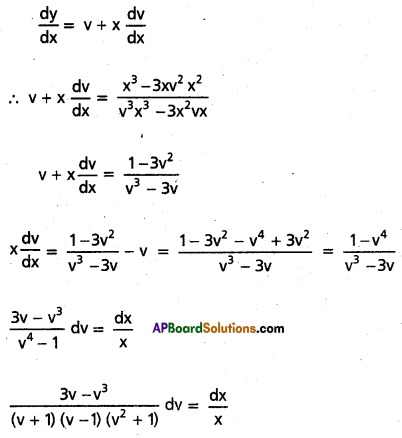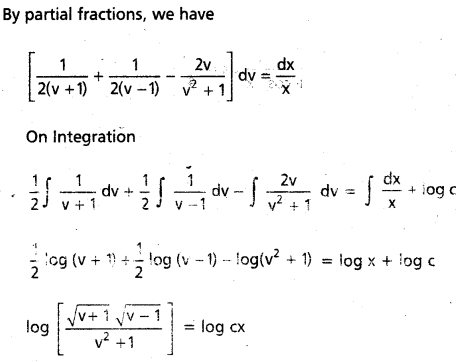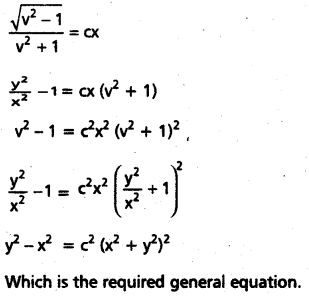Access to a variety of AP Inter 2nd Year Maths 2B Model Papers and AP Inter 2nd Year Maths 2B Question Paper May 2018 allows students to familiarize themselves with different question patterns.
AP Inter 2nd Year Maths 2B Question Paper May 2018
Time : 3 Hours
Max. Marks : 75
Note : This question paper consists of three sections A, B and C.
Section – A (10 × 2 = 20)
I. Very Short Answer Type Questions.
- Attempt all questions.
- Each question carries two marks.
Question 1.
Find the equation of the circle passing through (3, 4) and having the centre at (-3, 4).
Solution:
Let P = (3, 4) and d = (-3, 4)
r = dp
= \(\sqrt{(-3-3)^2+(4-4)^2}\)
= \(\sqrt{36}\)
= 6
∴ The equation of the circle passing through (3, 4) and having the centre at (-3, 4) is
(x + 3)2 + (y – 4)2 = 62
⇒ x2 + 6x + 9 + y2 – 8y + 16 = 36
⇒ x2 + y2 + 6x – 8y – 11 = 0
Question 2.
If the length of the tangent from (5, 4) to the circle x2 + y2 + 2ky = 0 is ‘1’ then find ‘k’.
Solution:
Let S = x2 + y2 + 2ky = 0
Given \(\sqrt{S_{11}}\) = 1
⇒ \(\sqrt{25+16+2 . k .4}\) = 1
⇒ 41 + 8k = 1
⇒ 8k = -40
⇒ k = -5
![]()
Question 3.
Find the angle between the circles x2 + y2 – 12x – 6y + 41 = 0, x2 + y2 + 4x + 6y – 59 = 0.
Solution:
Given circle equations are x2 + y2 – 12x – 6y + 41 = 0
x2 + y2 + 4x + 6y – 59 = 0
d1 = (6, 3) and r1 = \(\sqrt{36+9-41}\) = 2
d2 = (-2, -3) and r2 = \(\sqrt{4+9+59}\) = \(\sqrt{72}\) = 0
d = d1d2 = \(\sqrt{(-2-6)^2+(-3-3)^2}\) = \(\sqrt{64+36}\) = 10
Let ‘θ’ be the angle between the circles
∴ cos θ = \(\frac{d^2-r_1^2-r_2^2}{2 r_1 r_2}\)
= \(\frac{100-4-72}{2.2 .6 \sqrt{2}}\)
= \(\frac{24}{24 \sqrt{2}}\)
= \(\frac{1}{\sqrt{2}}\)
∴ θ = 45°
Question 4.
If (\(\frac{1}{2}\), 2) is one extremity of a focal chord of the parabola y2 = 8x, find the co-ordinates of the other extremity.
Solution:
Given parabola equation is y2 = 8x
Here 4a = 8 ⇒ a = 2
Given that one extremity of focal chord
(at2, 2at) = (\(\frac{1}{2}\), 2)
⇒ 2at = 2
⇒ at = 1
⇒ 2.t = 1
⇒ t = \(\frac{1}{2}\)
∴ The other extremity of focal chord = \(\left(\frac{a}{t^2}, \frac{-2 a}{t}\right)\)
= \(\left(\frac{2}{\left(\frac{1}{2}\right)^2}, \frac{-2.2}{\frac{1}{2}}\right)\)
= (8, -8)
Question 5.
Find the equation of the hyperbola whose foci are (±5, 0), the transverse axis is of length 8.
Solution:
Given Foci are (±5, 0)
∴ ae = 5
Length of transverse axis = 8
⇒ 2a = 8
⇒ a = 4
ae = 5 ⇒ 4e = 5 ⇒ e = \(\frac{5}{4}\)
We know b2 = a2(e2 – 1)
= 16(\(\frac{25}{16}\) – 1)
= 25 – 16
= 9
∴ Equation of the hyperbola is \(\frac{x^2}{a^2}\) – \(\frac{y^2}{b^2}\) = 1
⇒ \(\frac{x^2}{16}\) – \(\frac{y^2}{9}\) = 1
⇒ 9x2 – 16y2 = 144
Question 6.
Evaluate: \(\int \frac{(3 x+1)^2}{2 x}\)dx x ∈ I ⊂ R – {0}
Solution:
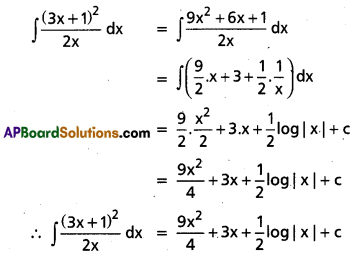
Question 7.
Evaluate : \(\int \frac{\log x}{x^2}\)dx on (0, ∞)
Solution:
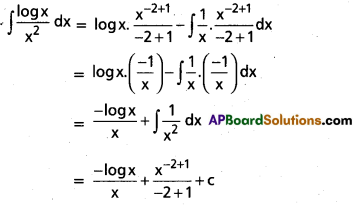

Question 8.
Evaluate : \(\lim _{n \rightarrow \infty} \frac{2^k+4^k+6^k+\ldots \ldots+(2 n)^k}{n^{k+1}}\) by using the method of finding definite integral of the limit of a sum.
Solution:
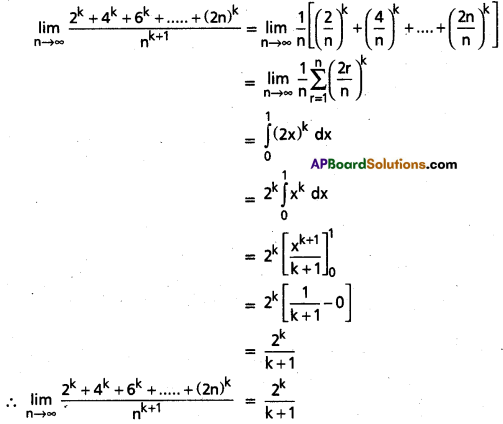
Question 9.
Find the value of \(\int_0^{2 \pi}\)sin2x cos4x dx .
Solution:
\(\int_0^{2 \pi}\)sin2cos4x dx = 4\(\int_0^{\frac{\pi}{2}}\)sin2x.cos4x dx
= 4.\(\frac{4-1}{2+4}\).\(\frac{4-3}{2+4-2}\).\(\frac{1}{2}\).\(\frac{\pi}{2}\)
= 4.\(\frac{3}{6}\).\(\frac{1}{4}\).\(\frac{1}{2}\).\(\frac{\pi}{2}\)
= \(\frac{\pi}{8}\)
∴ \(\int_0^{2 \pi}\)sin2xcos4x dx = \(\frac{\pi}{8}\)
Question 10.
Solve \(\frac{d y}{d x}\) = ex-y + x2e-y.
Solution:
\(\frac{d y}{d x}\) = ex – y + x2e-y
⇒ \(\frac{d y}{d x}\) = ex . e-y + x2e-y
⇒ \(\frac{d y}{e^{-y}}\) = ∫(ex + x2) dx
⇒ ey dy = ( ex + x2) dx
Integrating
∫eydy = ∫(ex + x2) dx + c
⇒ ey = ex + \(\frac{x^3}{3}\) + c
Section – B
II. Short Answer Type Questions.
- Answer ANY FIVE questions.
- Each question carries FOUR marks,
Question 11.
Find the equation of the circle with centre (-2, 3) cutting a chord length 2 units on 3x + 4y + 4 = 0.
Solution:
Given chord equation is 3x + 4y + 4 = 0
Centre d = (-2, 3)
d = Length of the perpendicular from d to the line \(\overline{\mathrm{AB}}\)
= \(\frac{|3(-2)+4(3)+4|}{\sqrt{3^2+4^2}}\)
= \(\frac{|-6+12+4|}{\sqrt{25}}\)
= \(\frac{10}{5}\)
Given length of the chord = 2
⇒ 2\(\sqrt{r^2-d^2}\) = 2
⇒ \(\sqrt{r^2-d^2}\) = 1
⇒ r2 – d2 = 1
⇒ r2 – 4 = 1
⇒ r2 = 5
⇒ r = \(\sqrt{5}\)
Required circle equation is (x – h)2 + (y – k)2 = r2
⇒ (x + 2)2 + (y – 3)2 = (\(\sqrt{5}\))2
⇒ x2 + 4x + 4 + y2 – 6y + 9 = 5
⇒ x2 + y2 + 4x – 6y + 8 = 0
![]()
Question 12.
Find the equation of the circle which passes through origin and intersects the circles x2 + y2 – 4x + 6y + 10 = 0, x2 + y2 + 12y + 6 = 0 orthogonally.
Solution:
Let x2 + y2 + 2gx + 2fy + c = 0 …….. (1) be the required circle.
If (1) passes through origin then c = 0
If (1) is orthogonal to x2 + y2 – 4x + 6y + 10 = 0 then 2g(-2) + 2f(3) = c + 10
⇒ -4g + 6f = 0 + 10
⇒ -2g + 3f = 5
⇒ 2g – 3f + 5 = 0 ………… (2)
If (1) is orthogonal to x2 + y2 + 12y + 6 = 0 then 2g(0) + 2f (6) = c + 6
⇒ 12f = 6
⇒ f = \(\frac{1}{2}\)
From (2)
2g – 3(\(\frac{1}{2}\)) + 5 = 0
⇒ 4g – 3 + 10 = 0
⇒ 4g + 7 = 0
⇒ g = \(\frac{-7}{4}\)
Hence required circle equation is x2 + y2 + 2(\(\frac{-7}{4}\))x + 2(\(\frac{1}{2}\))y + 0 = 0
⇒ x2 + y2 – \(\frac{7}{2}\)x + y = 0
⇒ 2x2 + 2y2 – 7x + 2y = 0
Question 13.
Find the length of the latus rectum, eccentricity, centre and foci of the ellipse 4x2 + y2 – 8x + 2y + 1 = 0.
Solution:
Given ellipse equation is 4x2 + y2 – 8x + 2y + 1 = 0
⇒ 4(x2 – 2x + 1 – 1) + (y2 + 2y + 1 – 1) + 1 = 0
⇒ 4 (x – 1 )2 – 4 + (y + 1 )2 – 1 + 1 = 0
⇒ 4(x – 1)2 + (y + 1)2 = 4
⇒ \(\frac{(x-1)^2}{1}\) + \(\frac{(y+1)^2}{4}\) = 1
Here a2 = 1 ⇒ a = 1
b2 = 4 ⇒ b = 2
∴ a < b
∴ Length of the latus rectum = \(\frac{2 a^2}{b}\) = \(\frac{2.1}{2}\) = 1
eccenticity = \(\sqrt{\frac{b^2-a^2}{b^2}}\) = \(\sqrt{\frac{4-1}{4}}\) = \(\frac{\sqrt{3}}{2}\)
centre = (-1, 1)
Foci = (-1, 1±2.\(\frac{\sqrt{3}}{2}\))
= (-1, 1±\(\sqrt{3}\))
Question 14.
A circle of radius 4 is concentric with the ellipse 3x2 + 13y2 = 78. Prove that a common tangent is inclined to the major axis at an angle \(\frac{\pi}{4}\).
Solution:
Given ellipse equation is 3x2 + 13y2 = 78
⇒ \(\frac{3 x^2}{78}\) + \(\frac{13 y^2}{78}\) = 1
⇒ \(\frac{x^2}{26}\) + \(\frac{y^2}{6}\) = 1
∴ Centre of the ellipse is (0, 0)
∴ Equation of the circle is (x – 0)2 + (y – 0)2 = 42
⇒ x2 + y2 = 16
Equation of tangent at p(θ) to the circle is x(4 cos θ) + y (4 sin θ) = 16
x cos θ + y sin θ = 4
⇒ y sin θ = – x cos θ + 4
⇒ y = \(\left(\frac{-\cos \theta}{\sin \theta}\right)\) + \(\frac{4}{\sin \theta}\) ………. (2)
If (2) s a tangent to the ellipse then
c2 = a2m2 + b2
⇒ \(\left(\frac{4}{\sin \theta}\right)^2\left(\frac{-\cos \theta}{\sin \theta}\right)^2\) = 26\(\left(\frac{-\cos \theta}{\sin \theta}\right)^2\) + 6
⇒ \(\frac{16}{\sin ^2 \theta}\) = 26.\(\frac{\cos ^2 \theta}{\sin ^2 \theta}\) + 6
⇒ 16 = 26 cos2θ + 6(1 – cos2θ)
⇒ 16 = 26 cos2θ + 6 – 6 cos2θ
⇒ 20 cos2θ = 10
⇒ cos2θ = \(\frac{1}{2}\)
⇒ cos θ = \(\frac{1}{\sqrt{2}}\)
∴ θ = \(\frac{\pi}{4}\)
Question 15.
Tangents to the hyperbola \(\frac{x^2}{a^2}\) – \(\frac{y^2}{b^2}\) = 1 angles θ1, θ2 with transverse axis of a hyperbola.
Show that the point of intersection of these tangents lies on the curve 2xy = k(x2 – a2) when tan θ1 + tan θ2 = k.
Solution:
Given hyperbola equation is \(\frac{x^2}{a^2}\) – \(\frac{y^2}{b^2}\) = 1
Equations of the tangents to the hyperbola can be taken as y = mx ± \(\sqrt{a^2 m^2-b^2}\)
Let P(x1, y1) be the point of intersection of the tangents.

⇒ 2x1y1 = K(\(x_1^2\) – a2)
∴ The point P(x1, y1) lies on the curve
2xy = K(x2 – a2)
Question 16.
Evaluate : \(\int_0^{\frac{\pi}{4}}\)log(1 + tanx)dx.
Solution:

= \(\frac{\pi}{4}\)log 2
∴ I = \(\frac{\pi}{8}\)log 8
Hence \(\int_0^{\pi / 4}\)log(1 + tan x)dx = \(\frac{\pi}{8}\) log 2
Question 17.
Solve : \(\frac{1}{x} \frac{d y}{d x}\) + y ex = \(e^{(1-x) e^x}\)
Solution:
Given \(\frac{1}{x} \cdot \frac{d y}{d x}\) + y.ex = x.\(e^{-(x-1) e^x}\) …….. (1)
This is a linear differential equation of first order is y.
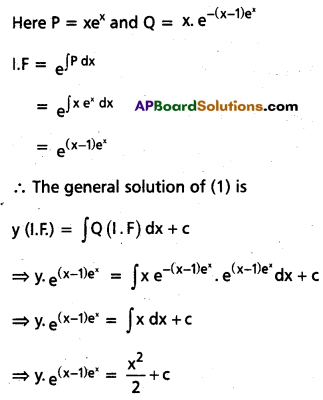
Section – C
III. Long Answer Type Questions.
- Answer ANY FIVE questions.
- Each question carries SEVEN marks.
Question 18.
Find the equation of the circle passing through (2, 1), (5, 5) and (-6, 7).
Solution:
Let x2 + y2 + 2gx + 2fy + c = 0 ………. (1) be the required circle.
If (1) passes through (2, 1) then
4 + 1 + 2g(2) + 2f(1) + c = 0
⇒ 4g + 2f + c = -5 …….. (2)
If (1) passes through (5, 5) then
25 + 25 + 2g(5) + 2f(5) + c = 0
⇒ 10g + 10f + c = -50 ……. (3)
If (1) passes through (-6, 7) then
36 + 49 + 2g(-6) + 2f(7) + c = 0
⇒ 85 – 12g + 14f + c = 0
⇒ 12g – 14f – c = 85 ……….. (4)
(3) – (2) ⇒ 6g + 8f = – 45 ⇒ 6g + 8f + 45 = 0 ………. (5)
(4) + (3) ⇒ 22g – 4f = 35 ⇒ 22g – 4f – 35 = 0 ………. (6)
Solving (5) and (6), we get

\(\frac{g}{-280+180}\) = \(\frac{f}{990+210}\) = \(\frac{1}{-24-176}\)
\(\frac{g}{-100}\) = \(\frac{f}{1200}\) = \(\frac{1}{-200}\)
g = \(\frac{1}{2}\), f = -6
From (2)
4(\(\frac{1}{2}\)) + 2(-6) + c = -5
2 – 12 + c = -5
c = 5
∴ g = \(\frac{1}{2}\), f = -6, c = 5
Hence required circle equation is
x2 + y2 + 2\(\left(\frac{1}{2}\right)\)x + 2(-6)y + 5 = 0
⇒ x2 + y2 + x – 12y + 5 = 0.
![]()
Question 19.
Show that x2 + y2 – 6x – 9y + 13 = 0, x2 + y2 – 2x – 16y =0, circles touch each other. Find the point of contact and the equation of common tangent at their point of contact.
Solution:
Let S1 = x2 + y2 – 6x – 9y + 13 = 0
s2 = x2 + y2 – 2x – 16y = 0
d1 = (3, \(\frac{9}{2}\)), d2 = (1, 8)
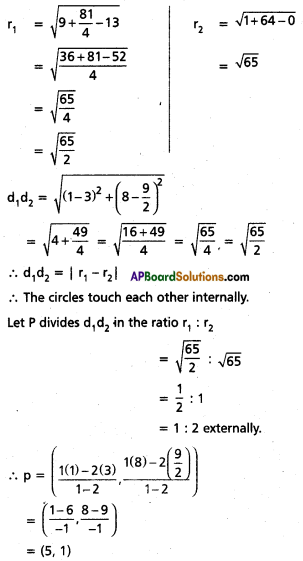
Equation of the common tangent is S1 – S2 = 0
⇒ -4x + 7y + 13 = 0
4x – 7y – 13 = 0
Question 20.
Find the equation of the parabola whose axis is parallel to x-axis and which passes through the points (-2, 1), (1, 2) and (-1, 3).
Solution:
Axis is parallel to X-axis, general equation be x = ay2 + by + c ……… (1)
(1) Passes through (-2, 1)
⇒ 2 = a + b + c ……………. (2)
(1) Passes through (1, 2)
⇒ 1 = 4a + 2b + c ………. (3)
(1) Passes through (-1, 3)
⇒ – 1 = 9a + 3b + c …….. (4)
(3) – (2) ⇒ 3a + b = 3 ……… (5)
(4) – (3) ⇒ 5a + b = – 2 …… (6)

Required parabola equation is
x = –\(\frac{-5}{2}\)y2 + \(\frac{21}{2}\)y – 10
⇒ 2x = -5y2 + 21y – 20
⇒ 5y2 + 2x – 21y + 20 = 0.
Question 21.
Evaluate : ∫(6x + 5)\(\sqrt{6-2 x^2+x}\) dx
Solution:
Let 6x + 5 = A(1 – 4x) + B
Equating the coefficients of x
6 = -4A ⇒ A = \(\frac{-3}{2}\)
Equating the constants
A + B = 5
B = 5 – A = 5 + \(\frac{3}{2}\) = \(\frac{13}{2}\)
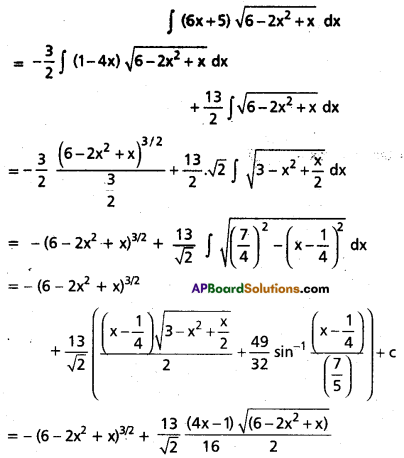
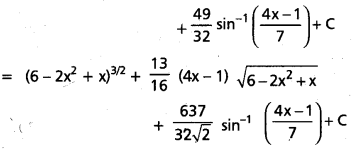
Question 22.
If In = ∫cosn x dx then show that In = \(\frac{1}{n}\)cosn-1x sin x + \(\frac{n-1}{n}\)In-2, n being a positive integer n ≥ 2 and deduce the value of ∫cos5x dx.
Solution:
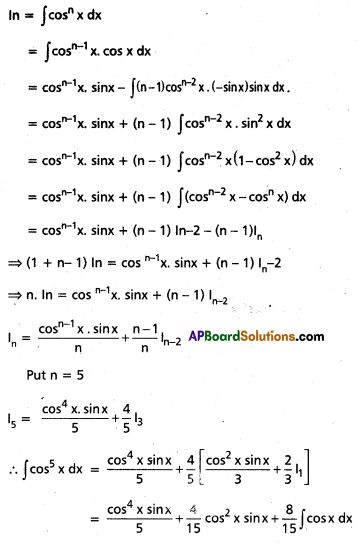

Question 23.
Evaluate: \(\int_0^\pi \frac{x \sin x}{1+\cos ^2 x} d x\)
Solution:
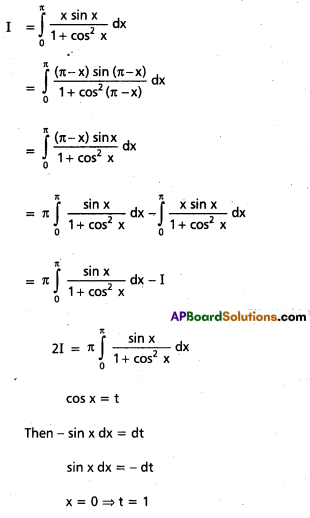

![]()
Question 24.
Solve (x3 – 3xy2) dx + (3x2y – y3) dy = 0.
Solution:
Given (x3 – 3xy2) dx + (3x2y – y3) dy = 0
⇒ (x3 – 3xy2) dx = -(3x2y – y3) dy
⇒ \(\frac{\mathrm{dy}}{\mathrm{dx}}\) = \(\frac{x^3-3 x y^2}{-3 x^2 y+y^3}\)
which is a homogeneous equation.
Put y = vx
